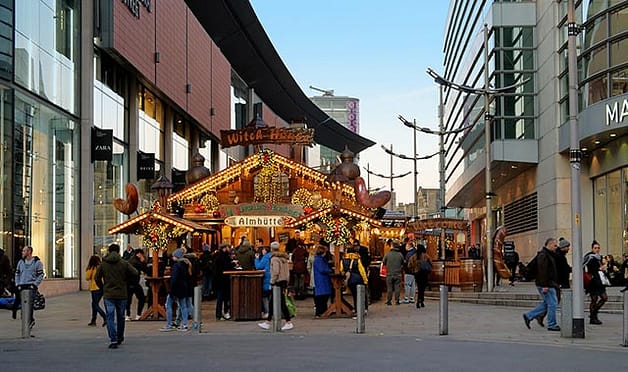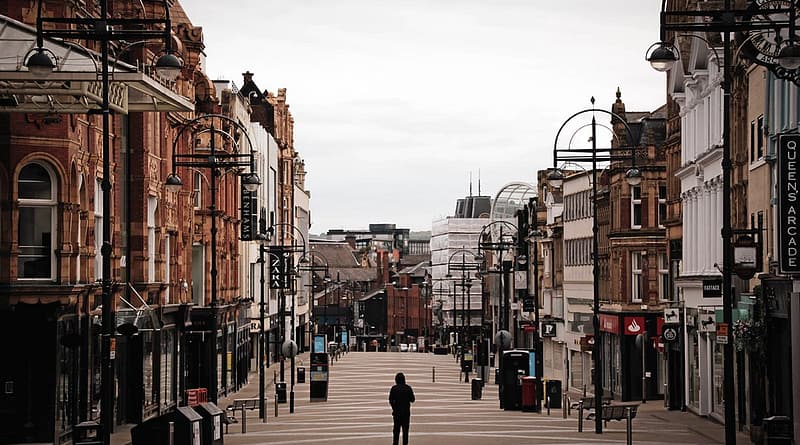Footfall counting essential to regenerate town centres, says study
In the UK and around the world the high street is undergoing a period of disruptive change. Rather than just improving shopping, town centres need to improve community cohesion, wellbeing and sustainability. But there has been very little progress say scientists from Cardiff University and Manchester Metropolitan University
Traditionally, policy makers have focused on retail occupancy – how many retail premises are open for business and what percent are vacant. In their recent paper, Dr Christine Mumford and co-authors argue that this approach is outdated. Policy makers should instead focus on footfall data showing activity volumes and patterns. The authors argue that adopting this activity-based approach to defining and classifying centres will radically alter the way in which they are developed and managed, improving them for everyone.
Pedestrian counts are a key indicator of town centre vitality
Dr Christine Mumford and her co-authors define footfall data, or pedestrian counting, as “the number of people walking up and down a given town centre (or single street) regardless of their reasons for doing so”. This is a key indicator of town centre vitality and viability.
Rather than making assumptions about potential numbers of visitors based on catchment, or assessing ‘attractiveness’ according to the retail offer, counting footfall tells us how many people are actually using a place.
The researchers analysed hourly footfall data from 155 town and city centres to discover patterns of use, the centre’s different functions and its level of attractiveness (volume of footfall). They developed a classification of town centres to reflect their different uses and created a hierachy based upon how busy they are.
Traditionally, footfall counts have been linked to the level of attractiveness of a location and its ability to satisfy catchment needs successfully, as well as an indicator of potential spend. However, as footfall provides a means to measure daily, weekly and yearly patterns of visitor behaviour in a place, it can also reveal gaps in terms of consumer behaviour and experience.

What type of town is yours?
After analysing the data, the scientists characterised towns as ‘comparison shopping’, ‘holiday’, ‘speciality’ and ‘multifunctional’. Comparison shopping towns had a noticeable peak in footfall in the lead-up to Christmas. Holiday and speciality have low footfall in December and high footfall in August. The multifunction towns had relatively flat footfall throughout the year with no noticeable peaks or troughs.
The comparison towns are mostly cities or large towns. For example, Manchester is a major UK shopping destination. In 2017 it was assessed as the leading retail centre outside of London. Manchester is consistently rated highly for its proportion of premium and luxury retail, range of retail choice, lack of retail vacancy, strength of retail rents and the amount of consumer spend. Manchester has invested in a free bus service, TV and radio advertising campaigns and Christmas markets in order to draw shoppers away from The Trafford Centre (a major out-of-town retail development).

Altrincham, winner of England’s Best High Street in 2018, is an example of a multifunctional town. Encouraging a diversity of uses in the town has been at the heart of its marketing and management strategies. Over recent years a variety of footfall anchors have been reinstated or upgraded in the town, including a library, a transport interchange and a hospital. In addition, more people now live and work in the town. On the back of this, retail has been revitalised, especially with the reinvention of the traditional market hall into a food hall, along with an influx of independent retailers.
Footfall proposed as a universal measure of activity to classify places
As footfall has been cited as the ‘lifeblood’ of a town centre’s vitality and viability, the researchers propose footfall as a universal measure of activity, that provides a means of classifying place based on the patterns and volumes of usage.
There are distinct advantages to having ongoing, continuous, and reliable footfall counts. As far back as 1994 UK government guidance strongly encouraged local authorities to measure footfall as a key indicator of vitality and viability.
Inclusive counting with video footfall measurments
Video people counting has the benefits of recency, accessibility, anonymity and is not dependent upon any form of technology used by an individual. It is an inclusive measure.
Using the Internet-of-Things, video footfall counts can be part of the smart city. The counting system uses either IP-enabled cameras, or can be added to existing CCTV cameras.
Continuous footfall monitoring essential for planning
The footfall obtained from continuous footfall counting is an objective criterion by which planners can check the designation of centres in networks and hierarchies. The researchers say “Footfall is a very responsive indicator as it based on the real-time behaviour of people, rather than estimates of catchment or shopper populations (which are a function of multiple-retailer representation) or data from telephone surveys of peoples shopping habits, which suffer from all the usual methodological flaws”.
The authors of the report believe that the identification of signature types achieved with footfall data will help understand the changing nature of town centres and high streets and help with planning and adapting to changing times.
References and Further Reading
Mumford C, Parker C, Ntounis N, Dargan E. Footfall signatures and volumes: Towards a classification of UK centres. Environment and Planning B: Urban Analytics and City Science. 2021;48(6):1495-1510. doi:10.1177/2399808320911412
Blackett, L (2017) Manchester named UK’s ‘top shopping destination outside London’
Retail Sensing (2020) Why counting pedestrians is at the heart of a smart city
If you would like information about our footfall counting in town and city centres, please get in touch.
